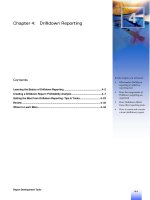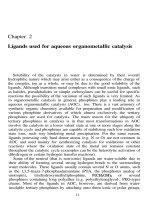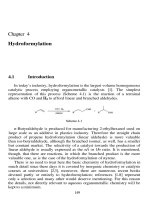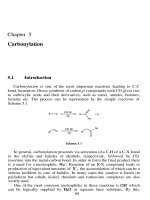Tài liệu Chapter 4: Hydroformylation pdf
Bạn đang xem bản rút gọn của tài liệu. Xem và tải ngay bản đầy đủ của tài liệu tại đây (1.14 MB, 42 trang )
Chapter 4
Hydroformylation
4.1 Introduction
In today`s industry, hydroformylation is the largest volume homogeneous
catalytic process employing organometallic catalysts [1]. The simplest
representation of this process (Scheme 4.1) is the reaction of a terminal
alkene with CO and to afford linear and branched aldehydes.
n-Butyraldehyde is produced for manufacturing 2-ethylhexanol used on
large scale as an additive in plastics industry. Therefore the straight chain
product of propene hydroformylation (linear aldehyde) is more valuable
than iso-butyraldehyde, although the branched isomer, as well, has a smaller
but constant market. The selectivity of a catalyst towards the production of
linear aldehyde is usually expressed as the n/i or 1/b ratio. It is mentioned,
though, that there are reactions, in which the branched product is the more
valuable one, as is the case of the hydroformylation of styrene.
There is no need to treat here the basic chemistry of hydroformylation in
much detail since these days it is covered by inorganic chemistry or catalysis
courses at universities [2,3], moreover, there are numerous recent books
devoted partly or entirely to hydroformylation; references [1-8] represent
only a selection and many other would deserve mentioning. For this reason
the details, not directly relevant to aqueous organometallic chemistry will be
kept to a minimum.
149
150
Chapter 4
Following O. Roelen`s original discovery in 1938, hydroformylation (the
oxo-process) employed cobalt carbonyls as catalyst, which later became
“modified” with tertiary phosphines, e.g. with (Shell, 1964). The
modified cobalt catalyst allowed reactions run at lower temperature and
pressure, but still suffered from rather low n/i
selectivity. The next
fundamental step in developing a less expensive and more selective way of
industrial hydroformylation was the introduction of rhodium-phosphine
catalysts in the mid-nineteen seventies, which allowed milder conditions and
brought about high selectivity towards the linear product. It is now firmly
established, that the two key catalytic species in the rhodium-catalyzed
hydroformylation processes are the coordinatively unsaturated complexes
and It is also generally accepted, that
the n/i ratio of the resulting aldehydes is controlled by the concentration
ratio of these two rhodium species, i.e. the more is
formed during catalysis relative to the higher is the
linear/branched selectivity. This is one of the reasons a high phosphine
excess is needed for good linearity of the product aldehydes. The very mild
conditions (120 °C, 30 bar i.e. syngas) made possible by the
catalyst, eliminated most of the side-reactions (aldol-type
condensations). However, with all three basic variants of industrial
hydroformylation, the metal complex catalyst (plus the
excess of phosphine)
was dissolved in a common liquid phase together with the substrate and
products. Special processes of catalyst recovery had to be operated and
acocrding to some procedures the catalysts were oxidized and extracted into
an aqueous phase as metal salts. In addition, the final aldehyde mixture had
to be purified from the remaining alkene and phosphine by distillation,
leading to further side reactions. Obviously, on the industrial scale
significant loss of rhodium during catalyst recovery and recycling cannot be
tolerated.
The idea of recovering the catalyst without distillation or destructive
methods had surfaced rather early (1973) in connection with the phosphine-
modified cobalt catalysts. Tris(aminoalkyl)phosphine complexes were
examined as catalysts which were extracted from the product mixture
without decomposition by an aqueous acid wash, and could be reextracted to
the organic (reaction) phase after neutralization [9,10]. Although the
feasibility of the method was demonstrated, perhaps the economic
advantages of a better catalyst recovery were insufficient in the light of the
relatively low cobalt price. It was in 1975 that Rhône Poulenc patented the
process of aqueous/organic biphasic hydroformylation of olefins using the
trisulfonated triphenylphoshine ligand, TPPTS, which later led to the
development of the widely known Ruhrchemie-Rhône Poulenc process of
propene hydroformylation.
Hydroformylation
151
With a water-soluble hydroformylation catalyst the overwhelming
majority of the reactions take place in an aqueous/organic biphasic mixture
for the simple reason of most olefins being insoluble in water. Research in
aqueous organometallic hydroformylation is therefore directed to several
aims:
- design and synthesis of new catalysts with improved chemical
properties (activity, selectivity, stability)
- design and synthesis of new ligands and catalysts with improved
physical properties (water solubility, distribution between the aqueous and
organic phases, possibility to manipulate solubility properties by
temperature variation, surface activity, etc.)
- engineering aspects (facilitating mass transport between the two
phases, interphase engineering, volume ratio of aqueous to organic phase,
continous or occasional counterbalancing of catalyst degradation, separation
by membrane technics, etc.)
- use of additives to improve the catalysts` properties or engineering
factors.
During the years many studies were directed to find optimal catalysts and
conditions for aqueous (or aqueous/organic biphasic) hydroformylation. By
nature of research, not all of them led to industrial breakthroughs but all
contributed to the foundations of today`s practical processes and future
developments. These investigations will not be treated in detail, however, a
selection of them is listed in Table 4.1.
152
Chapter 4
There are many reviews covering the field [1-31] and some of them are
really authentic with regard to the industrial realization of aqueous/organic
biphasic hydroformylation. The annual reviews on hydroformylation [32]
also give more and more space to the biphasic oxo-reaction. It is appropriate
to mention here, however, that aqueous organometallic hydroformylation
covers more than the Ruhrchemie-Rhône Poulenc process, and offers a good
chance to probe ideas on catalyst synthesis, catalyst recovery and reaction
engineering in general.
4.2 Rhodium-catalyzed biphasic hydroformylation of
olefins. The Ruhrchemie-Rhône Poulenc process for
manufacturing butyraldehyde
In 1975 Kuntz has described that the complexes formed from various
rhodium-containing precursors and the sulfonated phosphines, TPPDS (
2
) or
TPPTS (
3
) were active catalysts of hydroformylation of propene and 1-
hexene [15,33] in aqueous/organic biphasic systems with virtually complete
retention of rhodium in the aqueous phase. The development of this
fundamental discovery into a large scale industrial operation, known these
days as the Ruhrchemie-Rhône Poulenc (RCH-RP) process for
hydroformylation of propene, demanded intensive research efforts [21,28].
The final result of these is characterized by the data in Table 4.2 in
comparison with cobalt- or rhodium-catalyzed processes taking place in
homogeneous organic phases.
The process itself is stunningly simple [1, 6-8]. Propene and syngas are
fed to a well stirred tank reactor containing the aqueous solution of the
Hydroformylation
153
catalyst. By the time the organic phase leaves the reactor conversion of
propene is practically complete. Part of the reaction mixture is continously
transferred to a separator where the organic and aqueous phases are
separated, and the aqueous catalyst solution is taken back to the reactor. The
organic phase is stripped with fresh synthesis gas and finally the the product
is fractionated to n- and iso-butyraldehyde.
The first plant of 100.000 t/year capacity in Oberhausen, Germany
started operation in 1984. The capacity at that site (now belonging to
Celanese AG) has been expanded and today, together with the production of
a new plant in South Korea, the amount of butyraldehyde manufactured by
the RHC-RP process totals around 600.000 t/year. The average results of
fifteen years of continous operation show that for Celanese, using an own
technology (i.e. no license fees have to be paid) the overall manufacturing
costs are about 10 % less for the aqueous/organic biphasic process than for a
classical rhodium-phosphine catalyzed homogeneous hydroformylation. An
additional environmental benefit is in the reduced amount of byproducts and
wastes characterized by the low E-factor of 0.04 (ratio of byproducts to the
desired product(s), weight by weight [59]), which at some point becomes an
economic benefit, too. All the experience gained since 1984 confirm that
even large scale industrial processes can be based on (biphasic) aqueous
organometallic catalysis.
There are many important points and lessons to be learned from the
development and operation of the Ruhrchemie-Rhône Poulenc process and
we shall now have a look at the most important ones.
The mutual solubility of the components of the reaction mixture in each
other is the Alpha and Omega of the development of a biphasic system. The
distribution of the catalyst within the aqueous/organic mixture defines the
concentration of rhodium carried away from the reactor in the product
stream. Was this concentration high (above ppb level) it would mean a
serious economic drawback due to loss of an expensive component of the
reaction system. In addition, the product would have to be purified from
traces of the catalyst. The same is true for the distribution of the ligand
,
especially when a high ligand excess is required, which is the case with the
rhodium-phosphine catalyzed hydroformylation. The need for a high
phosphine excess can be satisfied only with ligands of sufficiently high
absolute solubility. The choice of trisulfonated triphenylphosphine seems to
be the best compromise of all requirements. TPPTS has an enormous
solubility in water (1100 g/L [7]), yet it is virtually insoluble in the organic
phase of hydroformylation due to its high ionic charge. For the same
reason, TPPTS has no surfactant properties which could lead to
solubilization of hidrophilic components in the organic phase. (This is also
important from engineering points of view: surfactants may cause frothing
154
Chapter 4
and incomplete phase separation during the workup procedure.)
Consequently, TPPTS stays in the aqueous phase and at the same time it is
able to keep all rhodium there. It is also expected on these grounds, that any
products of catalyst/ligand degradation will have a preferential solubility in
water. It is worth comparing these properties of TPPTS and TPPMS.
Monosulfonated triphenylphosphine has a much lower solubility in water
(12 g/L [55]). In addition, TPPMS is a pronounced surfactant [56], which
may be beneficial for the mass transport between the phases
(see later) but
certainly diadvantageous in phase separation. From the solubility side and in
principle, the same is true for any surfactant in the
system, be it a
specifically designed surfactant phosphine ligand [30,57] or special
additives [16,58]. In practice, phase separation difficulties and minute losses
of catalyst may go unnoticed or may be tolerable in laboratory experiments
but could cause serious problems on larger scale.
Solubility of the reactants and products in the catalyst-containing
aqueous phase is another factor to be considered. The solubility of >C3
terminal olefins rapidly decreases with increasing chain length [7] as shown
in Table 4.3. The solubility data in the middle column of Table 4.3 refer to
room temperature, therefore the values for ethene through 1-butene
show the
solubility of gases, while the data for 1-pentene through 1-octene refer to
solubilities of liquids. For comparison, the solubilities of liquid propene and
1-butene are also shown (third column), these were
calculated using a
known relation between aqueous solubility and molar volume of n-alkenes
[60].
The consequence of low alkene solubility is in that industrially the RCH-
RP process can be used only for the hydroformylation of C2-C4 olefins. In
all other cases the overall production rate becomes unacceptably low. This is
what makes the hydroformylation of higher olefins one of the central
problems in aqueous/organic biphasic catalysis. Many solutions to this
problem have been suggested (some of them will be discussed below),
however, any procedure which increases the mutual solubility of the organic
components and the aqueous ingredients (co-solvents, surfactants) may
Hydroformylation
155
threaten the complete recycling of rhodium. Interestingly, although the
solubility of ethene is high enough for an effective hydroformylation with
the catalyst dissolved in water, propanal is not
produced by this method. The reason is in that propanal is fairly miscible
with water. Consequently, the water content of the product has to be
removed by distillation, moreover, the wet propanal dissolves and removes
some of the catalyst out of the reactor, necessitating a tedious catalyst
recovery. This calls attention to the importance of the solubility of water in
the organic phase (and not only vice versa). It is also good to remember, that
mutual solubilities of the components of a reacting mixture may change
significantly with increasing conversion.
Formation of the catalyst and catalyst degradation are also important
questions. The rhodium-TPPTS catalyst is usually pre-formed from Rh(III)-
precursors, e.g. Rh(III)-acetate, in the presence of TPPTS with
synthesis gas
under hydroformylation conditions. During this process the precursors are
transformed into the Rh(I)-containing catalyst,
Catalyst degradation during hydroformylation arises from side reactions of
TPPTS leading to formation of phosphido-bridged clusters, inactive in
catalysis. Oxidative addition of a coordinated phosphine ligand onto the
rhodium leads to formation of a phosphidorhodium(III)-aryl intermediate
which under hydroformylation conditions yields 2-formyl-benzenesulfonic
acid (Scheme 4.2). In fact, the
meta
-position of the formyl and sulfonate
groups in the product gives evidence in favour of this route as opposed to
ortho
-metallation [23].
TPPTS is periodically added to the reactor in order to keep the catalyst
activity above a technologically desired value, but when it still declines
below that then the whole aqueous phase is taken out of the reactor and
replaced by a fresh aqueous solution of and TPPTS.
The spent catalyst solution is then worked up for rhodium and for the non-
degraded part of TPPTS.
When working with aqueous solutions one always has to keep in mind
the possible effects of or This is the case here, as well. The pH of
the solutions has to be controlled to avoid side reactions of the product
156
Chapter 4
aldehydes. Equally important is the fact, that the catalyst is also influenced
by changes in the pH - this will be discussed in 4.1.4. For this reason the pH
of the aqueous phase in the RCH-RP process is kept between 5 and 6.
4.3 Aqueous/organic biphasic hydroformylation butenes
and other alkenes
The only other olefin feedstock which is hydroformylated in an
aqueous/organic biphasic system is a mixture of butenes and butanes called
raffinate-II [8,61,62]. This low-pressure hydroformylation is
very much
like
the RCH-RP process for the production of butyraldehyde and uses the same
catalyst. Since butenes have lower solubility in water than propene,
satisfactory reaction rates are obtained only with increased catalyst
concentrations. Otherwise the process parameters are similar (Scheme 4.3),
so much that hydroformylation of raffinate-II or propene can even be carried
out in the same unit by slight adjustment of operating parameters.
Raffinate-II typically consists of 40 % 1-butene, 40 % 2-butene and 20 %
butane isomers. does not catalyze the
hydroformylation of internal olefins, neither their isomerization to terminal
alkenes. It follows, that in addition to the 20 % butane in the feed, the 2-
butene content will not react either. Following separation of the aqueous
catalyts phase and the organic phase of aldehydes, the latter is freed from
dissolved 2-butene and butane with a counter flow of synthesis gas. The
crude aldehyde mixture is fractionated to yield n-valeraldehyde (95 %) and
isovaleraldehyde (5 %) which are then oxidized to valeric acid. Esters of n-
valeric acid are used as lubricants. Unreacted butenes (mostly 2-butene) are
hydroformylated and hydrogenated in a high pressure cobalt-catalyzed
process to a mixture of isomeric amyl alcohols, while the remaining
unreactive components (mostly butane) are used for power generation.
Production of valeraldehydes was 12.000 t in 1995 [8] and was expected to
increase later.
Hydroformylation of higher olefins provide long chain alcohols which
find use mainly as plasticizers. No aqueous/organic biphasic process is
operated yet for this reaction, for several reasons. First, solubility of higher
olefins is too small to achieve reasonable reaction rates without applying
special additives (co-solvents, detergents, etc.) or other means (e.g.
Hydroformylation
157
sonication) in order to facilitate mass transfer between the phases. Second,
the industrial raw materials for production of plasticizer alcohols contain
mainly internal alkenes which cannot be hydroformylated with the
catalyst. The catalyst`s activity is even more important
in the light of the fact that with longer chain olefins (>C10) the crude
aldehyde cannot be separated from the unreacted olefin by distillation;
therefore a complete conversion of the starting material is highly desired.
4.4 Basic research in aqueous organometallic
hydroformylation; ligands and catalysts
In the preceeding two sections aqueous hydroformylation was mostly
discussed in the context of industrial processes. It is, of course, impossible
to categorize investigations as “purely industrial” and “purely
academic”
since the driving force behind the studies of a practically so important
chemical transformation such as hydroformylation, ultimately arises from
industrial needs. Nevertheless, several research projects have been closely
associated with the developmental work in industry, while others explore the
feasibility of new ideas without such connections.
Ligand synthesis and purification, coordination chemistry of transition
metals (Ag, Au, Mn, Fe, Ru, Co, Rh, Ir, Ni, Pd, Pt) with TPPTS, and
catalysis by the new complexes has been significantly advanced by studies
of the Munich group of Herrmann [1,4-8,63-65] in close collaboration with
researchers of Ruhrchemie, later Hoechst AG. Among the new phosphines
synthetized purposefully for aqueous biphasic hydroformylation the
sulfonated diphosphines BISBIS (
46
) [66], NAPHOS (
45
) and BINAS (
44
)
[67-69] deserve special mention. In fact, the rhodium complexes of these
chelating phosphines showed much higher activity and (with the exception
of NORBOS) an even better selectivity, than the Rh/TPPTS catalyst. For
example, with Rh/BINAS turnover frequencies of could be
achieved [69] under optimal conditions (100-130 °C, 20-60 bar syngas,
[P]/[Rh] 10:1-50:1). This means, that the activity of this catalyst is
approximately ten times higher, than that of Rh/TPPTS. At the same time
Rh/BINAS gives a n/i selectivity of 99/1 in contrast to 95/5 with
Rh/TPPTS. These figures are very impressive, however, the industrial
process still uses the Rh/TPPTS catalyst, mostly due to the higher cost and
easier degradation of BINAS compared to TPPTS.
A water-soluble diphosphine ligand with large bite angle was prepared
by controlled sulfonation of XANTHPHOS. The rhodium complex of the
resulting ( (
51
) showed a catalytic activity in
propene hydroformylation comparable to Rh/TPPTS (TOF 310 vs at
120 °C, 9 bar propene and 10 bar ) [70]. The regioselectivity
158
Chapter 4
was very high (n/i ratio 30-35) as expected taking the large bite angle of the
phosphine ligand [71]. Conversely, and the dibenzofuran-
based phosphine ligand 28 gave a catalyst which was much inferior to
Rh/TPPTS both in activity and in selectivity (n/i ratio 2.4)
[72].
Although cobalt is prominently featured in the history of oxo-synthesis
and in industrial hydroformylation, only a few papers deal with the
formation and catalytic properties of its water-soluble phosphine complexes
[65]. Most probably the reason is in that these cobalt-phosphine complexes
show modest catalytic activity under hydroformylation conditions in
aqueous/organic biphasic systems. This has been demonstrated by using
cobalt based catalysts with TPPTS and with 21 as ligands for the
hydroformylation of 1-hexene and 1-octene [73]. Under 15 bar (room temp.)
syngas and at 190 °C 10-100 turnovers were observed in 14 h with a n/i ratio
generally less than 2. It is of interest that alcohol formation was negligible.
Nevertheless, cobalt/TPPTS is suggested for hydroformylation of internal
olefins ([154]).
The reaction of and four equivalents of in
THF gave which actively catalyzed the biphasic
hydroformylation of 1-pentene [74]. In a water/benzene mixture, at 100 °C
and 40 bar syngas this substrate was quantitatively converted to hexanal (43
% yield) and 2-methylpentanal (57 %) in 20 h. At the [substrate]/[catalyst]
ratio of 90 this is equivalent to a minimum TOF of The catalyst was
recycled in the aqueous phase three times with no changes in its activity or
selectivity.
In biphasic hydroformylations with the catalyst,
polyethylene glycols (PEG-s) of various chain lengths can be used to
increase the solubility of higher olefins in the aqueous phase with no
apparent losses of the catalyst [8]. Very interestingly, was found to
react with neat PEG with liberation of HCl which had to be
pumped off for
quantitative complex formation. An aqueous solution of the resulting
glycolate complex was used for hydroformylation of various
olefins including 1-dodecene, 2,4,4-trimethylpent-l-ene and styrene in
biphasic systems [75]. The most surprising in these findings is the high
reactivity of the hindered olefins comprising technical diisobutylene (a
mixture of 76 % 2,4,4-trimethylpent-l-ene and 24 % 2,4,4-trimethylpent-2-
ene) for which a TOF could be achieved at 100 °C with 100 bar
initial syngas pressure. Aldehyde selectivity was almost quantitative for 1-
hexene, 1-dodecene, diisobutylene and styrene, and the latter was
hydroformylated with an outstanding regioselectivity As
mentioned in 4.1.2 alkene mixtures such as diisobutylene are used as raw
materials for the production of plasticizer alcohols in homogeneous catalytic
Hydroformylation
159
hydroformylations with cobalt catalysts. Therefore a metal complex capable
of efficient catalysis of the same reaction under mild conditions in a
biphasic system would be most valuable. It should be noted, however, that
low level rhodium leaching (1.9 ppm) from the aqueous to the organic phase
was determined by photometric analysis.
A series of studies deals with the catalytic activity of the dinuclear
thiolate-bridged rhodium complex in the
hydroformylation of propene, 1-hexene and 1-octene (Scheme 4.4) [76-80].
Turnover frequencies up to were detected.
The basic question here is in that whether the dinuclear structure breaks
up or remains intact during catalysis. With propene and 1-hexene it was
found that at low syngas pressures (5-10 bar) the dinuclear catalyst showed
higher selectivity towards the formation of linear aldehydes
than referring to the existence of different catalytic
species in the two systems [76-80]. Similarly, the analogous
could be recovered unchanged from a reaction
mixture of 1-hexene hydroformylation [81]. (It seems appropriate to mention
here that recovery of the catalyst was achieved by treating the homogeneous
organic reaction mixture with dilute aqueous sulfuric acid; the N-protonated
complex precipitated quantitatively. The catalyst could be reextracted to the
organic phase after regeneration of the organosoluble dinuclear complex by
the addition of aqueous base.) The complex
was also active in the hydroformylation of 1-hexene with (up to
calculated for the dimer
)
[76], and again showed different
properties than (Scheme 4.5). However, in another
study on the hydroformylation of 1-octene in the presence of various
cosolvents, it was concluded that most of the catalytic activity was due to
mononuclear rhodium complex(es) formed by decomposition of the
dinuclear catalyst [78]. This question is still not completely resolved, most
160
Chapter 4
probably both mono- and dinuclear species act as catalysts in such
hydroformylations.
Very recently it was disclosed, that the water-soluble dinuclear complex
obtained in the reaction of and 11-mercaptoundecanoic
acid catalyzed the aqueous/organic biphasic hydroformylation of styrene and
various arene-substituted styrenes with good activity and useful selectivity
to the branched aldehydes (Scheme 4.6) [82]. Below pH 4 the acid form of
the complex precipitated virtually
quantitatively but could be redissolved in water on addition of base.
Importantly, higher olefins could also be hydroformylated by this catalyst
(for 1-octene: at 55 °C, 35 bar syngas, ).
In the quest for suitable solvent systems the
complex was found to catalyze the hydroformylation of 1-
hexene in water-methanol/isooctane (1/1/1, v/v/v) yielding heptanal and 2-
methylhexanol in a ratio of 2.2 (80 °C, 30 bar syngas) [83]. An important
point here is in that the biphasic micture becomes homogeneous above
60 °C, but phase separation occurs again upon cooling to room temperature.
This kind of solvent behaviour may lead to fast reactions at higher
Hydroformylation
161
temperature where the system is homogeneous, coupled with the possibility
of catalyst recovery after phase separation at low temperatures.
4.5 Mechanistic considerations
4.5.1 Effects of water
The
effect
of water
on the
conversion
and
selectivity
of
cobalt-catalyzed
hydroformylations has long been noticed in industry [7,85,86]. A systematic
study [87] of this effect in hydroformylation of 1-octene with
with and without revealed that addition of water, and especially when
it formed a separate aqueous phase, significantly increased the
hydrogenation activity of the phosphine-modified catalyst. Under the same
reaction conditions (190 °C, 56 bar 1:1, P:Co 3:1), approximately
40 % nonanols were formed instead of 5 % observed with water-free
solutions. No clear explanation could be given for this phenomenon,
although the possible participation of water itself in the hydroformylation
reaction through the water gas shift was mentioned. It was also established,
that the hydroformylation was severly retarded in the
presence of water. Under the conditions above, 95 % conversion was
observed in 15 hour with no added water, while only 10 % conversion to
aldehydes (no alcohols) was found in an aqueous/organic biphasic reaction.
Similar observations were made in the hydroformylation of 2,5-
dimethoxy-2,5-dihydrofuran [88]. While in toluene the catalyst led
to exclusive formation of 2,5-dimethoxy-tetrahydrofuran-3-carbaldehydes,
in an aqueous solution or in water/toluene mixtures only hydrogenated
products were formed with Rh/TPPTS (Scheme 4.7). Direct involvment of
was suggested through the WGSR giving preference for hydrogenation
over hydroformylation. Support for this idea comes from experiments with
surfactant phosphines (e.g. ), since with such ligands
the rhodium catalyst gave increased amounts of aldehydes. This
phenomenon was rationalized in that with surfactant ligands the catalyst acts
in the less-aqueous environment of micelles unlike
which is dissolved in the bulk aqueous phase. Although this explanation
may be true, it does not account for the lack of hydrogenation activity of the
Rh/TPPTS catalyst in hydroformylation of other olefins (e.g. practically no
propane is formed in the RCH-RP process).
162
Chapter 4
In the hydroformylation of alkenes, the major differences between the
and catalysts are the lower activity
and higher selectivity of the water-soluble complex in aqueous/organic
biphasic systems. Lower activity is not unexpected, since alkenes have
limited solubility in water (see 4.1.1.1, Table 3). On the other hand, the
higher selectivity towards formation of the linear product deserves more
scrutiny.
In general, the mechanism of alkene hydroformylation with an
catalyst in water or in aqueous/organic biphasic systems
is considered to be analogous [61] to that of the same reaction
in homogeneous organic solutions [84], a basic version of which
is shown on Scheme 4.8.
High pressure and NMR measurements showed no formation of
any new species in a solution of TPPTS up to 200
Hydroformylation
163
bar 1:1 [89]. This is in sharp contrast to the case of
which quantitatively gives already
under 30 bar 1:1, in the presence of 3 equivalents of These
observations refer to a less probable dissociation of TPPTS from
than that of from The
activation energy of phosphine exchange, calculated from the line width of
variable temperature NMR spectra was, indeed, higher for TPPTS than
for notably vs. The value for the
water-soluble complex was later redetermined at somewhat higher ligand
excess as a function of the ionic strength
arising from the ionic nature of the complex and TPPTS, as well as from
added (if any). For solutions of an activation energy
of phosphine exchange of was determined, while in the presence
of 100 mM an was found [90]. However, at high
catalyst concentration a much higher activation energy,
was given by the measurements, in perfect agreement with the
earlier investigations.
If we look now at the accepted mechanism of hydroformylation we can
easily recognize that the higher kinetic barrier to phosphine exchange
(dissociation) in case of will result in a
relatively low concentration of the species responsible
for the formation of branched aldehydes. The high excess of TPPTS applied
in industrial hydroformylation will shift the equilibria (Scheme 4.8) in
favour of higher phosphine species anyway, and this is further aided by the
increased ionic strength provided by the triply charged TPPTS. These two
effects will result in a concentration distribution of the active catalytic
species in favour of and hence in the observed high
selectivity towards linear aldehydes.
While this argument may explain the higher regioselectivity of
hydroformylations, the question still remains that why is it so, what makes
more stable in water than is in
toluene? At the first look one would expect just the opposite behaviour: nine
negative charges in one molecule should facilitate dissociation by mutual
repulsion. It has been suggested [89], that the cations of TPPTS and the
water molecules in the first hydration shell effectively shield this repulsion,
moreover, a network of ionic and hydrogen bonds with participation of the
groups, water and the cations, makes the three phosphine molecules a
virtual tridentate macroligand. Dissociation of a TPPTS molecule
necessitates a substantial reorganization of this network with considerable
energy requirement. Obtaining a direct proof for such a suggestion is not
easy, however, the effect of inert salts (or “spectator” cations) is in
accordance with the above hypothesis. It was demonstrated in
164
Chapter 4
hydroformylation of 1-octene [91] and 1-hexene [92] that salts like
and generally increased the n/i selectivity of
hydroformylations catalyzed by rhodium complexes of sulfonated phosphine
ligands. The effect was more pronounced with surfactant phosphines in
which case the higher ionic strength is known to stabilize the micelles
formed by these ligands.
4.5.2 Effects of pH
As mentioned earlier, in the Ruhrchemie-Rhône Poulenc process for
propene hydroformylation the pH of the aqueous phase is kept between 5
and 6. This seems to be an optimum in order to avoid acid- and base-
catalyzed side reactions of aldehydes and degradation of TPPTS.
Nevertheless, it has been observed in this [93] and in many other cases
[38,94-96,104,128,131] that the (P = water-soluble
phosphine) catalysts work more actively at higher pH. This is unusual for a
reaction in which (seemingly) no charged species are involved. For example,
in 1-octene hydroformylation with catalyst in a
biphasic medium the rates increased by two- to five-fold when the pH was
changed from 7 to 10 [93,96]. In the same detailed kinetic studies [93,96] it
was also established that the rate of 1-octene hydroformylation was a
significantly different function of reaction parameters such as catalyst
concentration, CO and hydrogen pressure at pH 7 than at pH 10.
In a related study the hydrogenation of was
investigated as a function of pH [97]. The reactions were run in a pH-static
hydrogenation reactor in which the amount of eventual acid (proton)
production could be measured quantitatively. By these measurements (and
with simultanous and NMR spectroscopy) it was unambigously
established that the formation equilibrium of (Eq. 4.1,
Figure 4.1) is mobile, and –other parameters being constant– is governed by
the pH. The most important conclusion which can be drawn from the data on
Figure 4.1 is in that is formed only to a negligible
extent below pH 5, but becomes the major species (>80 %) at pH 8 (under
conditions of Figure 4.1).
Although the measurements were made with the chloro-complex, it is
worth repeating the equation in a more general way (Eq. 4.2,
acetate, etc.):









